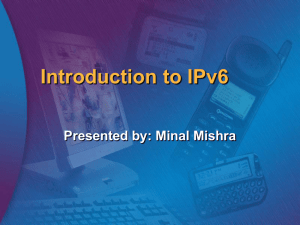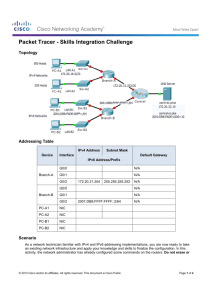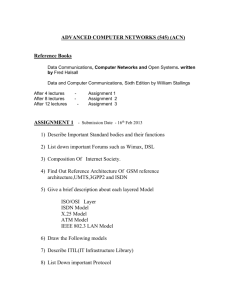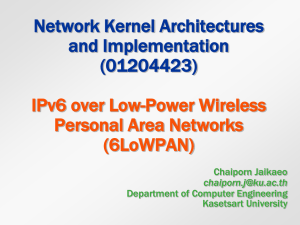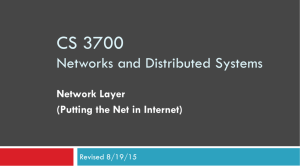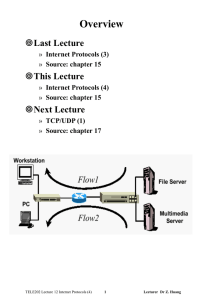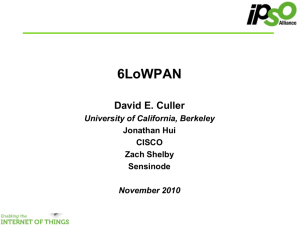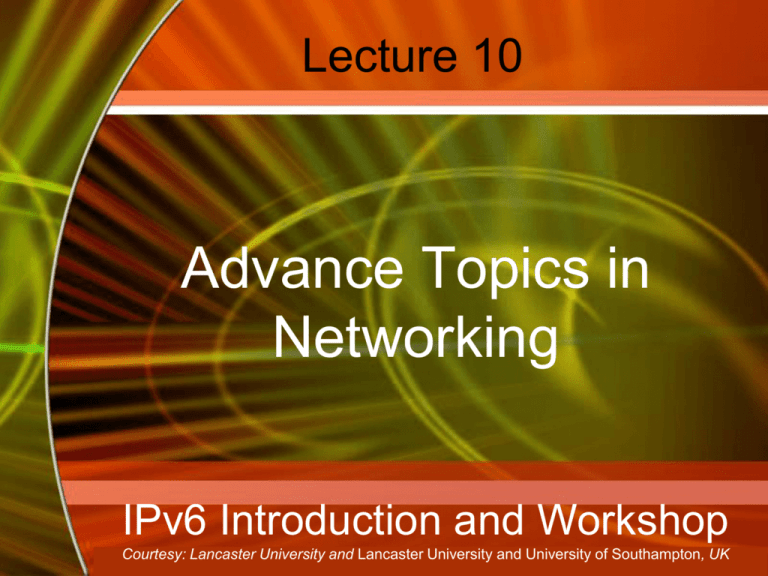
Lecture 10
Advance Topics in
Networking
IPv6 Introduction and Workshop
Courtesy:Technology
Lancaster
University and
Lancaster
and University
of Southampton,
McGraw-Hill
Education
Copyright
© 2006University
by The McGraw-Hill
Companies,
Inc. All rights UK
reserved.
Agenda
• IP Network Addressing
• Classful IP addressing
• Techniques to reduce address shortage in
IPv4
• Features of IPv6
• Header Comparisons
• Extension Headers
• Conclusions
IP Network Addressing
• INTERNET world’s largest public data
network, doubling in size every nine months
• IPv4, defines a 32-bit address - 232 (4,294,967,296)
IPv4 addresses available
• The first problem is concerned with the eventual
depletion of the IP address space.
• Traditional model of classful addressing does not
allow the address space to be used to its maximum
potential.
Classful Addressing
• When IP was first standardized in Sep 1981, each
system attached to the IP based Internet had to be
assigned a unique 32-bit address
• The 32-bit IP addressing scheme involves a two
level addressing hierarchy
Network Number/Prefix Host Number
Classful Addressing…
• Divided into 5 classes
• Class A 8 bits N/W id
and 24 bits host id and
so on B,C.
• Wastage of IP
addresses by assigning
blocks of addresses
which fall along octet
boundaries
Techniques to reduce address shortage in
IPv4
• Subnetting
• Classless Inter Domain Routing (CIDR)
• Network Address Translation (NAT)
Subnetting
• Three-level hierarchy: network, subnet, and
host.
• The extended-network-prefix is composed of
the classful network-prefix and the subnetnumber
• The extended-network-prefix has traditionally
been identified by the subnet mask
Network-Prefix
Subnet-Number Host-Number
Subnetting Example
128.10.1.1
H1
128.10.1.2 H2
Sub-network 128.10.1.0
Internet
G
All traffic
to 128.10.0.0
128.10.2.1 H3
128.10.2.2 H4
Net mask 255.255.0.0
Sub-network 128.10.2.0
Subnet mask 255.255.255.0
Classless Inter-Domain Routing
• Eliminates traditional classful IP routing.
• Supports the deployment of arbitrarily sized
networks
• Routing information is advertised with a bit
mask/prefix length specifies the number of leftmost
contiguous bits in the network portion of each routing table entry
• Example: 192.168.0.0/21
Network Address Translation
• Each organizationsingle IP address
• Within organization –
each host with IP unique
to the orgn., from
reserved set of IP
addresses
3 Reserved ranges
10.0.0.0 – 10.255.255.255 (16,777,216 hosts)
172.16.0.0 – 172.31.255.255/12 (1,048,576
hosts)
192.168.0.0 – 192.168.255.255/16 (65,536
hosts)
NAT Example
D
10.0.0.4
C
B
10.0.0.1
A
Source
Computer
Source
Computer's
IP Address
Source
Computer's
Port
NAT Router's
IP Address
NAT Router's
Assigned
Port Number
A
10.0.0.1
400
24.2.249.4
1
B
10.0.0.2
50
24.2.249.4
2
C
10.0.0.3
3750
24.2.249.4
3
D
10.0.0.4
206
24.2.249.4
4
Features of IPv6
• Larger Address Space
• Aggregation-based address hierarchy
– Efficient backbone routing
• Efficient and Extensible IP datagram
• Stateless Address Autoconfiguration
• Security (IPsec mandatory)
• Mobility
128-bit IPv6 Address
3FFE:085B:1F1F:0000:0000:0000:00A9:1234
8 groups of 16-bit hexadecimal numbers separated by “:”
Leading zeros can be removed
3FFE:85B:1F1F::A9:1234
:: = all zeros in one or more group of 16-bit hexadecimal numbers
Header comparison
15 16
0
vers
hlen
TOS
identification
20
bytes
TTL
31
total length
flags
protocol
flag-offset
header checksum
source address
destination address
• total length => payload
• protocol => next header
• TTL => hop limit
IPv4
traffic class
payload length
40
bytes
flow-label
next header
source address
destination address
• ID, flags, flag offset
• TOS, hlen
• header checksum
Changed (3)
options and padding
vers
Removed (6)
hop limit
Added (2)
• traffic class
• flow label
Expanded
• address 32 to 128 bits
IPv6
Major Improvements of
IPv6 Header
• No option field: Replaced by extension
header. Result in a fixed length, 40-byte IP
header.
• No header checksum: Result in fast
processing.
• No fragmentation at intermediate nodes:
Result in fast IP forwarding.
Extension Headers
• Routing – Extended routing, like IPv4 loose list
of routers to visit
• Fragmentation – Fragmentation and Reassembly
• Authentication – Integrity and authentication,
security
• Encapsulation – Confidentiality
• Hop-by-Hop Option – Special options that
require hop-by-hop processing
• Destination Options – Optional information to
be examined by the destination node
Stateless Address Autoconfiguration
• 3 ways to configure network interfaces:
Manually, Stateful, Stateless
• IPSAA IPv6 addr. Separated into 2 parts:
network and interface id.
• Link- local addresses: prefix FE80::0 +
interface identifier (EUI-64 format)
• Obtain network id through Router solicitation
(RS)
Stateless Address Autoconfiguration
• RFC 2373 dictates the conversion process,
which can be described as having two steps.
– The first step is to convert the 48-bit MAC address
to a 64-bit value. To do this, we break the MAC
address into its two 24-bit halves: the
Organizationally Unique Identifier (OUI) and the NIC
specific part. The 16-bit hex value 0xFFFE is then
inserted between these two halves to form a 64-bit
address.
Stateless Address Autoconfiguration
– The second step is to invert the universal/local (U/L)
flag (bit 7) in the OUI portion of the address.
– Globally unique addresses assigned by the IEEE
originally have this bit set to zero, indicating global
uniqueness.
– Likewise, locally created addresses, such as those
used for virtual interfaces or a MAC address
manually configured by an administrator, will have
this bit set to one.
– The U/L bit is inverted when using an EUI-64
address as an IPv6 interface ID.
Stateless Address Autoconfiguration
Step 1
Step 2
Router Configuration Example
Conclusion
IPv6 is NEW …
– built on the experiences learned from IPv4
– new features
– large address space
– new efficient header
– autoconfiguration
… and OLD
– still IP
– built on a solid base
– started in 1995, a lot of implementations and tests
have been done
References
• IPng wg:
http://playground.sun.com/pub/ipng/html
• NGtrans: http://www.6bone.net/ngtrans
• IPv6 users site: http://www.ipv6.org
• IPv6 Forum: http://www.ipv6forum.com
• FAQs RFC Repository:
http://www.faqs.org/rfcs/
The End
Questions?
McGraw-Hill Technology Education
Copyright © 2006 by The McGraw-Hill Companies, Inc. All rights reserved.

